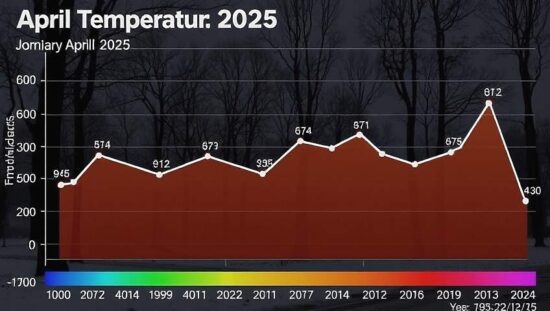Last month, April 2025, was the second hottest April on record, according to the European Union’s Earth observation program, Copernicus. The average surface temperature was 14.96 degrees Celsius, just 0.07 degrees cooler than the record-breaking April of 2024 and 0.07 degrees warmer than the third hottest April of 2016. The average temperature was 1.51 degrees higher than the pre-industrial level, which is used as a reference point. The April of 2025 was the 21st month within the last 22 months where the global average temperature was more than 1.5 degrees above the pre-industrial level. Also, the 12-month period from May 2024 to April 2025 was 1.58 degrees above the pre-industrial level.
The target of the Paris Climate Agreement, to limit the temperature rise to well below 2 degrees Celsius and preferably to 1.5 degrees Celsius compared to pre-industrial levels, is not yet breached, as it refers to a multi-year average. However, given the persistent high emissions of climate-damaging greenhouse gases, which reached a new record high in 2024, drastic CO2 reductions would be necessary to meet the target.
Furthermore, extreme events were observed in the ocean surface temperature and in the Arctic sea ice extent. The average ocean surface temperature in April 2025 was 20.89 degrees, the second highest value ever recorded for this month. The Arctic sea ice extent was 3% lower than the average and was the sixth lowest monthly extent for April in the 47-year history of satellite records. The sea ice extent in Antarctica was 10% lower than the average and the tenth lowest since the start of the record for this month.
In April 2025, many parts of Central Europe, Great Britain, South Fennoscandia and parts of Eastern Europe experienced below-average precipitation. On the other hand, most parts of Southern Europe, North Norway, South Finland and parts of West Russia experienced above-average rainfall. Heavy rainfall caused floods, landslides and avalanches in the Alpine region. Above-average wet weather conditions also prevailed in parts of Canada and Alaska, the central and eastern United States, parts of eastern and central Russia, southern Africa, northern Australia and central South America. In many of these regions, heavy rainfall led to flooding and related damages.
Germany’s federal government has agreed to the Paris Climate Agreement, which aims to limit the global warming to well below 2 degrees Celsius and preferably to 1.5 degrees Celsius compared to pre-industrial levels. According to analyses by scientists involved in the “Climate Action Tracker” the measures of the German government are almost sufficient to limit the temperature rise to below 2 degrees Celsius, but the 1.5-degree target will be missed. However, if it is assumed that the citizens of Germany have the same share of the remaining CO2 budget as all other people, the goal of the German government is insufficient to prevent a global warming of more than three degrees.





